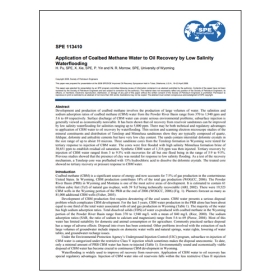
Development and production of coalbed methane involves the production of large volumes of water. The salinities and sodium adsorption ratios of coalbed methane (CBM) water from the Powder River Basin range from 370 to 1,940 ppm and 5.6 to 69 respectively. Surface discharge of CBM water can create serious environmental problems; subsurface injection is generally viewed as economically nonviable. It has been shown that oil recovery from reservoir sandstones can be improved by low salinity waterflooding for salinities ranging up to 5,000 ppm. There may be both technical and regulatory advantages to application of CBM water to oil recovery by waterflooding. Thin section and scanning electron microscope studies of the mineral constituents and distribution of Tensleep and Minnelusa sandstones show they are typically composed of quartz, feldspar, dolomite and anhydrite cements but have very low clay content. The sands contain interstitial dolomite crystals in the size range of up to about 10 microns. Three sandstone cores from the Tensleep formation in Wyoming were tested for tertiary response to injection of CBM water. The cores were first flooded with high salinity Minnelusa formation brine of 38,651 ppm to establish residual oil saturation. Synthetic CBM water of 1,316 ppm was then injected. Tertiary recovery by injection of CBM water ranged from 3 to 9.5% with recoveries for all but one flood being in the range of 5.9 to 9.5%. Previous studies showed that the presence of clay was needed for response to low salinity flooding. As a test of the recovery mechanism, a Tensleep core was preflushed with 15% hydrochloric acid to dissolve the dolomite crystals. The treated core showed no tertiary recovery or pressure response to CBM water.
(SPE 113410, University of Wyoming)